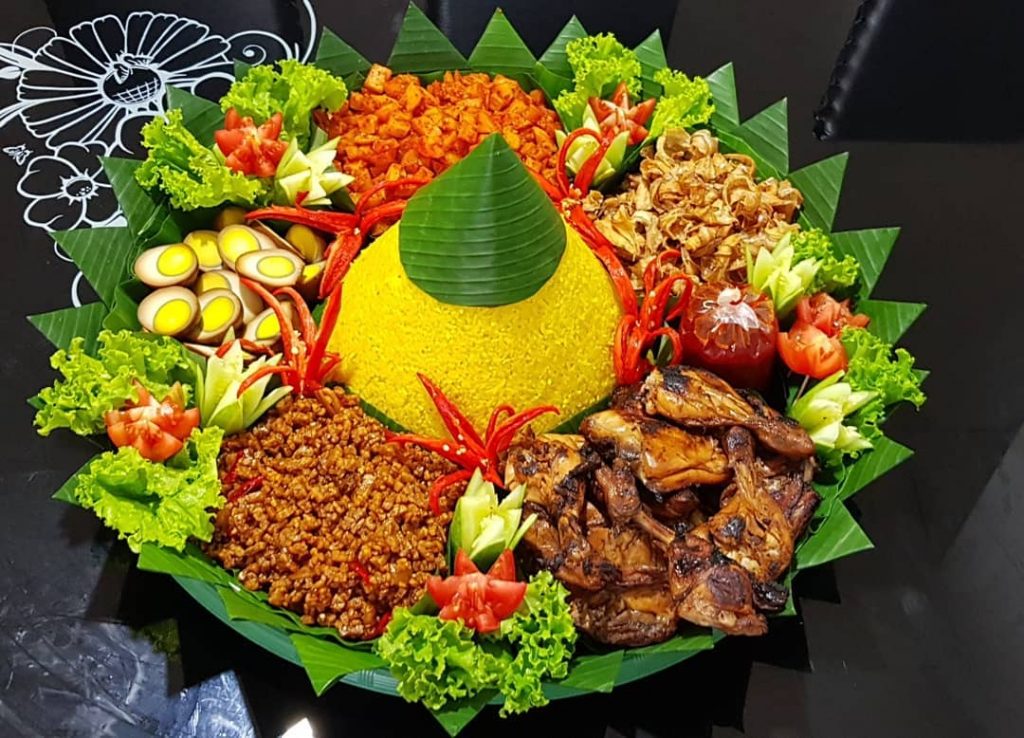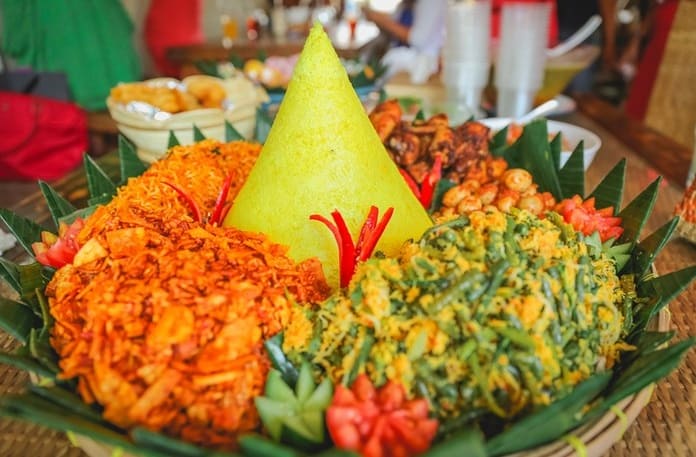Nasi Tumpeng originally comes from Indonesia and is commonly found in some Indonesian rituals. Not only coming of age tradition in Indonesia’s culture but also other celebrations. Before knowing the real meaning of Nasi Tumpeng for Indonesian, let’s take a deeper look over it from history, some facts, and meanings behind it.

History of Nasi Tumpeng
Nasi Tumpeng comes from Javanese culture which has unique taste and design. It made from rice that combines with the turmeric to make it yellow rice. It forms as a cone and manages with some side dishes such as an Indonesian noodle dish, which neatly put together on the Tampah ( a kind of traditional plate).

Commonly Nasi Tumpeng was made in the Java, Madura, and Bali islands. They made it as the ritual as their worship to God. Based on the Javanese culture, Tumpeng comes as the geographical condition in Java and Bali island which has a lot of active volcanoes.
That is why the form of Tumpeng made look like the volcano. People used to use the Tumpeng for their worship to God among the volcano. They believe that their God as they call as the Hyang lives in the volcano. They used to have faith in Hinduism so that their Hyang is their greatest God.
The Nasi Tumpeng formed by people in a way of the mount of Mahameru. They believed that their Hinduism angels and God were living there. That is why they made some worship based on what they had at that time from their agricultural product that cooked perfectly as their famous cultures in Indonesia.
Facts Of Nasi Tumpeng
There are so many facts of Nasi Tumpeng that you should know. Not only the color of the rice has to be yellow, but also it has to be in a cone way. Here we have some facts about Javanese culture in Nasi Tumpeng that will amaze you.

- Tumpeng is an acronym from the Javanese culture, Yen Metu Kudu Mempeng
- Tumpeng have to be made from rice, not other Indonesian staple food
- The side dish on Tumpeng have to be in a various way such as egg, chicken, meat, and some vegetables
- Tumpeng used to make for spiritual context as the worship for Hinduism God. Now it has made for any celebration such as birthday, anniversary, the baby born, or wedding.
- The side dish around has to be made from 7 types of dishes as the combination of the vegetable and meat which comes from the earth and the sea or water.
- The different city will be different Tumpeng also, but the meaning keep remain the same as the greatest gratitude to God
- Nasi Tumpeng is the symbol of happiness, gratitude, and blessing
- The top of Nasi Tumpeng can’t be cut because it is contradicting with the main philosophy
- The top of Nasi Tumpeng as the symbol of the only one God in this world
- The egg is the most side dish that has to there on the Nasi Tumpeng as the symbol of togetherness
Meanings of Nasi Tumpeng
There are so many meanings behind Nasi Tumpeng. Not only becomes some symbol of gratitude but the meaning is represented for human culture for Javanese and all of Indonesian. It made as to the representation of gratitude to God which has given them a grateful life.

The mean of tumpeng in Javanese culture as the acronym of the Metu Kudu Sing Mempeng, Mlebu Kudu Sing Kenceng. This acronym integrates with the 7 side dishes on its.
The basic means of Nasi Tumpeng is since the firstborn, people have to fight their life, has a meaningful life, and not easily discouraged by such common thing. We have to be brave enough to face the world so that we know which one is the right and the false.
The cone size made as to the symbol of the geographical condition in Indonesia. This means that not only in the Java and Bali island that have a lot of mountain and active volcanoes but also all around Indonesia.

Side dishes on the Nasi Tumpeng should come from the combination of food on earth and water or sea. This means that Nasi Tumpeng is the symbol of diversity in a great way. That we should be more kind of diversity as that make our life more beautiful.
The 7 type of side dishes on Nasi Tumpeng has the meaning of the seven help that comes from everywhere when we needed it the most. The 7 number in Javanese culture means as the Pitu as the Pitulungan or help.
The egg on the side dish means the togetherness in life. The fish means the struggle symbol as we have to fight for a better life. The chicken means for us to avoid the arrogant, selfish, and greedy character.

The vegetables on the side dish on Nasi Tumpeng means the protection and consideration while we want to decide something. Those vegetables are important to be our fortress on our life.
Those of the combination of rice and other dishes in Tumpeng means unity in our life. That we should keep it in a good way so that we can have a grateful life. So that we can avoid the bad thing that may come to us.

So there are some short explanations of Nasi Tumpeng from the history, facts, and meanings that you should know. In our daily life, sometimes we face a good thing and a bad thing. All we have to do is have some more gratitude to God. So, it can keep us to have a better life.
